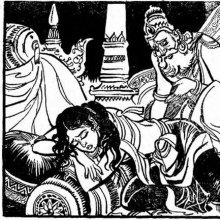Hunchback, Hunch-back: 2 definitions
Introduction:
Hunchback means something in Hinduism, Sanskrit. If you want to know the exact meaning, history, etymology or English translation of this term then check out the descriptions on this page. Add your comment or reference to a book if you want to contribute to this summary article.
Images (photo gallery)
In Hinduism
Natyashastra (theatrics and dramaturgy)
Source: Shodhganga: Elements of Art and Architecture in the Trtiyakhanda of the Visnudharmottarapurana (natya)The Hunch-back (movement) is associated with Prakampitā: one of the “five types of waist-movements ” (in Sanskrit Dramas), as conveyed through Āṅgikābhinaya: one of the four divisions of Abhinaya or “ways to convey or represent one’s emotion to others”, according to the Nāṭyaśāstra and the Viṣṇudharmottarapurāṇa, an ancient Sanskrit text which (being encyclopedic in nature) deals with a variety of cultural topics such as arts, architecture, music, grammar and astronomy.—The āṅgikābhinaya includes the histrionic representation of the limbs which is simply known as physical gestures. The Viṣṇudharmottarapurāṇa seems to take the word kaṭi in feminine gender and makes the divisions of waist movements in feminine gender. The Prakampitā represents a slightly shaking movement that should be adopted in the walking of hunch backs, dwarfs and persons of short height.

Natyashastra (नाट्यशास्त्र, nāṭyaśāstra) refers to both the ancient Indian tradition (shastra) of performing arts, (natya—theatrics, drama, dance, music), as well as the name of a Sanskrit work dealing with these subjects. It also teaches the rules for composing Dramatic plays (nataka), construction and performance of Theater, and Poetic works (kavya).
Shilpashastra (iconography)
Source: Shodhganga: Elements of Art and Architecture in the Trtiyakhanda of the Visnudharmottarapurana (shilpa)The Hunchback is associated withe the Sentiment of Humour (hāsya), which refers to one of the Nine Sentiments (citrarasa) in ancient Indian Painting (citra), according to the Viṣṇudharmottarapurāṇa, an ancient Sanskrit text which (being encyclopedic in nature) deals with a variety of cultural topics such as arts, architecture, music, grammar and astronomy.—According to the Viṣṇudharmottarapurāṇa, hāsya i.e., the sentiment of humour is reflected through the Painting of a person who is hunchback, dwarfish and somewhat deformed in appearance. [...] Thus, painting is a medium of showing the inner feelings and emotions of a painter which can strikes the inherent sentiments of connoisseur’s mind, for example: hunchback persons in the sentiment of humour.

Shilpashastra (शिल्पशास्त्र, śilpaśāstra) represents the ancient Indian science (shastra) of creative arts (shilpa) such as sculpture, iconography and painting. Closely related to Vastushastra (architecture), they often share the same literature.
See also (Relevant definitions)
Partial matches: Back.
Full-text (+45): Kubja, Kubjaka, Prakampita, Kurantippo, Kubada, Kunpantiyan, Kupro, Kunal, Kupracupre, Hunchback's mother, Bemgunu, Kupranu, Kuprinu, Ashtavakra, Culi, Mantharaka, Crocosmia paniculata, Trivakra, Kubjikatmaka, Short height.
Relevant text
Search found 54 books and stories containing Hunchback, Hunch-back, Hunch-backed, Hunchbacked; (plurals include: Hunchbacks, backs, backeds, Hunchbackeds). You can also click to the full overview containing English textual excerpts. Below are direct links for the most relevant articles:
The Jataka tales [English], Volume 1-6 (by Robert Chalmers)
Jataka 232: Vīṇā-Thūṇa-jātaka < [Book II - Dukanipāta]
Jataka 78: Illīsa-jātaka < [Book I - Ekanipāta]
Jataka 531: Kusa-jātaka < [Volume 5]
The Skanda Purana (by G. V. Tagare)
Chapter 203 - Greatness of Maṅkīśvara (Maṅkī-īśvara) < [Section 1 - Prabhāsa-kṣetra-māhātmya]
Chapter 23 - The Glory of Cakratīrtha: Āditya Gets Golden Hands < [Section 1 - Setu-māhātmya]
Chapter 34 - Description of Ravi Tīrtha < [Section 3 - Revā-khaṇḍa]
Ramayana of Valmiki (by Hari Prasad Shastri)
Chapter 7 - Shri Rama’s coming installation < [Book 2 - Ayodhya-kanda]
Chapter 78 - The hunchback, Manthara, incurs Prince Shatrughna’s displeasure < [Book 2 - Ayodhya-kanda]
Chapter 9 - Queen Kaikeyi is resolved upon her evil design < [Book 2 - Ayodhya-kanda]
Trishashti Shalaka Purusha Caritra (by Helen M. Johnson)
Part 16: Resumption of Nala story < [Chapter III - Vasudeva’s Marriage with Kanakavatī and her Former Incarnations]
Part 7: The sixth spoke < [Chapter XIII - Śrī Mahāvīra’s nirvāṇa]
Part 9: The story of Gāndhāra < [Chapter XI - The story of Rauhiṇeya]
Ishavasya Upanishad with Shankara Bhashya (Sitarama) (by S. Sitarama Sastri)
Puranic encyclopaedia (by Vettam Mani)
